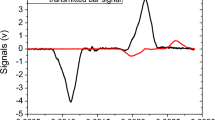Summary
The essential object of this study is to contribute to liberate the rheological study of fresh concrete from the present-day empiricism. For this an apparatus has been developed to determine the flow curve of the material and thus obtain its rheological equation of state.
Changes in rheological behaviour have thus been shown relative to the dynamic state of the material (vibrated or not), the solid concentration and the shape of the aggregate.
This study finally deals with the influence of the solid concentration, the grain size, the shape and nature of the aggregate on the viscosity of fresh mortars vibrated or at rest.
Similar content being viewed by others
Abbreviations
- A :
-
placé en indice ou en exposant d'un autre symbole, signifie que ce dernier se rapporte à des granulats anguleux
- C :
-
concentration en solide par rapport au volume total solide plus liquide\(\left( {C = \frac{{V_S }}{{V_S + V_E }}} \right)\)
- C p :
-
compacité
- d :
-
placé en indice d'un autre symbole, signifie que ce dernier se rapporte à un mortier au seuil de dilatance
- d m :
-
diamètre moyen
- i :
-
placé en indice d'un autre symbole, signifie que ce dernier se rapporte à un mortier au seuil d'instabilité
- M :
-
moment d'une force
- N :
-
nombre spécifique
- S :
-
placé en indice ou en exposant d'un autre symbole, signifie que ce dernier se rapporte à des granulats sphériques
- t :
-
temps
- V A :
-
volume gazeux
- V E :
-
volume liquide
- V S :
-
volume solide
- v A :
-
concentration en gaz\(\left( {v_A = \frac{{V_A }}{{V_A + V_E + V_S }}} \right)\)
- v E :
-
concentration en liquide\(\left( {v_E = \frac{{V_E }}{{V_A + V_E + V_S }}} \right)\)
- v S :
-
concentration en solide\(\left( {v_S = \frac{{V_S }}{{V_A + V_E + V_S }}} \right)\)
- ɛ′:
-
permittivité électrique par rapport au vide
- \(\dot \varepsilon \) :
-
vitesse de déformation— gradient de vitesse
- η pl :
-
coefficient de viscosité plastique
- \(\tilde \omega \) :
-
poids spécifique
- σ:
-
surface spécifique
- τ:
-
contrainte de cisaillement
- σ o :
-
seuil de cisaillement
- Ψ L :
-
coefficient de forme de Loudon
- Ω:
-
vitesse de rotation
References
Maso J.C.—La nature minéralogique des agrégats, facteur essentiel de la résistance des bétons à la rupture et à l'action du gel, Thèse, Toulouse, 1967.
Bergström S.G.—Stable concretes mixes. Meddelanden, no 24, Stockholm, 1951.
Eriksson A.G.—Development of Fluidity and Mobility Meters for Concrete Consistency Tests. Handlingar, no 12, Stockholm, 1949.
Bombled J.P.—Rhéologie du Béton frais. Publication Technique no 161, C.E.R.I.L.H., Paris, 1964. a: p.5, b: p. 6.
Groupe Français de Rhéologie.—Dictionnaire de Rhéologie, Annales de l'I.T.B.T.P., no 252, Paris, 1964.
Reiner M.—Rhéologie Théorique, Dunod, Paris, 1955. a: p. 150, b: p. 146, c: p. 111, d: p. 163.
VanWazer J.R., Lyons, J.W., Kim K.Y., Colwell R.E. —Viscosity and Flow Measurement, Interscience Publishers, Londres, 1963, p. 68.
Nessim A.A., Wajda R.L.— Magazine of Concrete Research, Volume 17, no 51, juin 1965.
L'Hermite R.—Idées actuelles sur la Technologie du Béton, I.T.B.T.P., Paris, 1965, p. 59.
Wilkinson W.L.—Non-newtonian Fluids Pergamon Press, Londres, 1960. a: p. 4, b: p. 5.
Essai proctor.—Modes opératoires du L.C.P.C., Dunod, Paris, 1966.
Duriez M., Arrambide J.—Nouveau Traité de Matériaux de Construction. 1, Dunod, Paris, 1961. a: p. 153, b: p. 243.
Von Hippel A.R.—Dielectrics and Waves, John Wiley, Londres, 1962, p. 231.
Mill C.C.—Rheology of disperse systems, Pergamon Press, New York, 1959, p. 120.
Green H., Roberts A.B.— Magazine of Concrete Research, Volume 15, no 44, juillet 1963.
Eirich F.R.—Rheology. 3, Academic Press, Londres, 1960, p. 189.
Persoz B.—Introduction à l'Etude de la Rhéologie, Dunod, Paris, 1960, p. 127.
Powers T.C.—The Properties of Fresh Concrete, John Wiley, New York, 1968, p. 16.
Kendall M.G., Stuart A.—The advanced Theory of Statistics. Volume 2, Griffin.
Thirriot C., Amoros D.—Les Fluides non-newtoniens dans le Contexte Industriel Français. Cahiers du Groupe Français de Rhéologie, no spécial, novembre 1970.
Author information
Authors and Affiliations
Additional information
Voir la première partie dans Matériaux et Constructions No 29 (sept.–oct. 1972), pp. 275–295.
Rights and permissions
About this article
Cite this article
Legrand, C. Contribution à l'étude de la rhéologie du béton frais. Mat. Constr. 5, 379–393 (1972). https://doi.org/10.1007/BF02476286
Issue Date:
DOI: https://doi.org/10.1007/BF02476286




